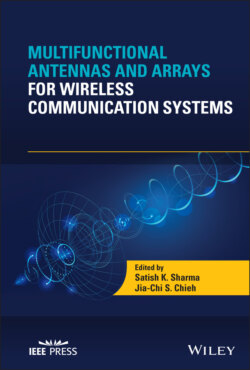Multifunctional Antennas and Arrays for Wireless Communication Systems

Реклама. ООО «ЛитРес», ИНН: 7719571260.
Оглавление
Группа авторов. Multifunctional Antennas and Arrays for Wireless Communication Systems
Table of Contents
List of Tables
List of Illustrations
Guide
Pages
Multifunctional Antennas and Arrays for Wireless Communication Systems
List of Contributors
Preface
Acknowledgements
1 Introduction
1.1 Introduction
1.2 Antenna: an Integral Component of Wireless Communications
1.3 Antenna Performance Parameters
1.4 Antenna Types
1.5 Multifunctional Antennas
1.6 Reconfigurable Antennas
1.7 Frequency Agile/Tunable Antenna
1.8 Antenna Measurements
1.9 Conclusion
References
2 Frequency Reconfigurable Antennas
2.1 Introduction
2.2 Mechanism of Frequency Reconfigurability
2.3 Types of FRAs
2.3.1 Frequency Reconfigurability by Switches/Tunable Components
2.3.1.1 Electrical Switches
2.3.1.2 Varactor Diodes
2.3.1.3 Micro‐Electro‐Mechanical‐System (MEMS) Switches
2.3.1.4 Optical Switches
2.3.1.5 Ground Plane Membrane Deflection
2.3.2 Frequency Reconfigurability Using Special Materials
2.3.2.1 Liquid Crystals
2.3.2.2 Graphene
2.3.3 Frequency Reconfigurability by Mechanical Changes
2.3.3.1 Actuators
2.3.3.2 Motors
2.3.4 Frequency Reconfigurability Using Special Shapes
2.3.4.1 Origami Antennas
2.3.4.2 Fractal Shapes
2.4 FRAs in the Future: Applications in Emerging Technologies
2.5 Conclusion
References
3 Radiation Pattern Reconfigurable Antennas
3.1 Introduction
3.2 Pattern Reconfigurable by Electronically Changing Antenna Elements
3.3 Pattern Reconfigurable by Electronically Changing Feeding Network
3.4 Mechanically Controlled Pattern Reconfigurable Antennas
3.5 Arrays and Optimizations
3.6 Reconfigurable Wearable and Implanted Antennas
3.7 Conclusion
References
4 Polarization Reconfigurable Antennas
4.1 Introduction
4.2 Polarization Reconfiguration Mechanism Using RF Switches
4.3 Solid‐State RF Switch‐Based Polarization Reconfigurable Antenna
4.4 Mechanical and Micro‐electro‐mechanical (MEMS) RF Switch‐Based Antennas
4.5 Switchable Feed Network‐Based Polarization Reconfiguration
4.6 Polarization Reconfigurable Antennas Using Metasurface
4.7 Other Methods to Create Polarization Reconfigurable Antennas
4.8 Conclusion
References
5 Liquid Metal, Piezoelectric, and RF MEMS‐Based Reconfigurable Antennas
5.1 Introduction
5.2 Liquid Metal – Frequency Reconfigurable Antennas
5.3 Liquid Metal – Pattern Reconfigurable Antennas
5.4 Liquid Metal – Directivity Reconfigurable Antennas
5.5 Piezoelectric – Pattern Reconfigurable Array
5.6 RF MEMS – Frequency Reconfigurable
5.7 RF MEMS – Polarization Reconfigurable
5.8 RF MEMS – Pattern Reconfigurable
5.9 Conclusion
References
6 Compact Reconfigurable Antennas
6.1 Introduction
6.2 Reconfigurable Pixel Antenna
6.3 Compact Reconfigurable Antennas Using Fluidic
6.4 Compact Reconfigurable Antennas Using Ferrite and Magnetic Materials
6.5 Metamaterials and Metasurfaces
6.6 Conclusion
References
7 Reconfigurable MIMO Antennas
7.1 Introduction
7.2 Reconfigurable Antennas for MIMO Applications
7.3 Isolation Techniques in MIMO Antennas
7.3.1 Decoupling Network
7.3.2 Neutralization Lines
7.3.3 Using Artificial Material
7.3.4 Defected Ground Plane
7.4 Pattern Diversity Scheme
7.5 Reconfigurable Polarization MIMO Antenna
7.6 MIMO Antenna Performance Parameters
7.6.1 Envelope Correlation Coefficient (ECC)
7.6.2 Total Active Reflection Coefficient (TARC)
7.6.3 Mean Effective Gain (MEG)
7.6.4 Diversity Gain
7.7 Some Reconfigurable MIMO Antenna Examples
7.8 Conclusion
References
8 Multifunctional Antennas for 4G/5G Communications and MIMO Applications
8.1 Introduction
8.2 MIMO Antennas in Multifunctional Systems
8.3 MIMO Antennas in Radar Systems
8.4 MIMO Antennas in Communication Systems
8.5 MIMO Antennas for Sensing Applications
8.6 MIMO Antennas for 5G Systems
8.7 Massive MIMO Array
8.8 Dielectric Lens for Millimeter Wave MIMO
8.9 Beamforming in Massive MIMO
8.10 MIMO in Imaging Systems
8.11 MIMO Antenna in Medical Applications. 8.11.1 Ex‐VIVO Applications
8.11.2 MIMO Antenna for Medical Imaging
8.11.3 Wearable MIMO Antenna
8.11.4 MIMO Indigestion Capsule
8.11.5 Reconfigurable Antennas in Bio‐Medical Engineering
8.12 Conclusion
References
9 Metamaterials in Reconfigurable Antennas
9.1 Introduction
9.2 Metamaterials in Antenna Reconfigurability
9.3 Metamaterial‐Inspired Reconfigurable Antennas
9.3.1 Metamaterial‐Based Frequency Reconfigurability
9.3.2 Metamaterial‐Based Pattern Reconfigurability
9.3.3 Metamaterial‐Based Polarization Reconfigurability
9.4 Metasurface‐Inspired Reconfigurable Antennas
9.5 Conclusion
References
10 Multifunctional Antennas for User Equipments (UEs)
10.1 Introduction
10.2 Lower/Sub‐6 GHz 5G Band Antennas
10.3 5G mm‐Wave Antenna Arrays
10.4 Collocated Sub‐6 GHz and mm‐Wave 5G Array Antennas
10.5 RF and EMF Exposure Limits
10.6 Conclusion
References
11 DoD Reconfigurable Antennas
11.1 Introduction
11.2 TACAN
11.2.1 TACAN Antenna
11.2.2 Course Bearing
11.2.3 Fine Bearing
11.3 Sea‐Based X‐Band Radar 1 (SBX‐1)
11.4 The Advanced Multifunction RF Concept (AMRFC)
11.5 Integrated Topside (InTop)
11.5.1 Wavelength Scaled Arrays
11.5.2 Low‐Cost Multichannel Microwave Frequency Phased Array Chipsets on Si and SiGe
11.6 DARPA Arrays of Commercial Timescales (ACT)
11.7 AFRL Transformational Element Level Array (TELA)
11.8 Conclusion
References
12 5G Silicon RFICs‐Based Phased Array Antennas
12.1 Introduction
12.2 Silicon Beamformer Technology
12.3 LO‐Based Phase Shifting
12.4 IF‐Based Phase Shifting
12.5 RF‐Based Phase Shifting
12.6 Ku‐Band Phased Arrays Utilizing Silicon Beamforming Chipsets
12.7 Ku‐Band Phased Arrays on ROHACELL Utilizing Silicon Beamforming Chipsets
12.8 Ku‐Band Phased Arrays with Wide Axial Ratios Utilizing Silicon Beamforming Chipsets
12.9 28 GHz Phased Arrays Utilizing Silicon Beamforming Chipsets
12.10 Phased Array Reflectors Utilizing Silicon Beamforming Chipsets
12.11 Conclusion
References
Index. a
b
c
d
e
f
g
h
i
l
m
n
o
p
r
s
t
v
w
y
z
WILEY END USER LICENSE AGREEMENT
Отрывок из книги
Edited by
.....
Figure 1.8 The simulated (solid lines) and measured (dash lines) total antenna efficiencies for (a) the reconfigurable states of the lower 4G bands and (b) the consistent higher frequency band.
.....